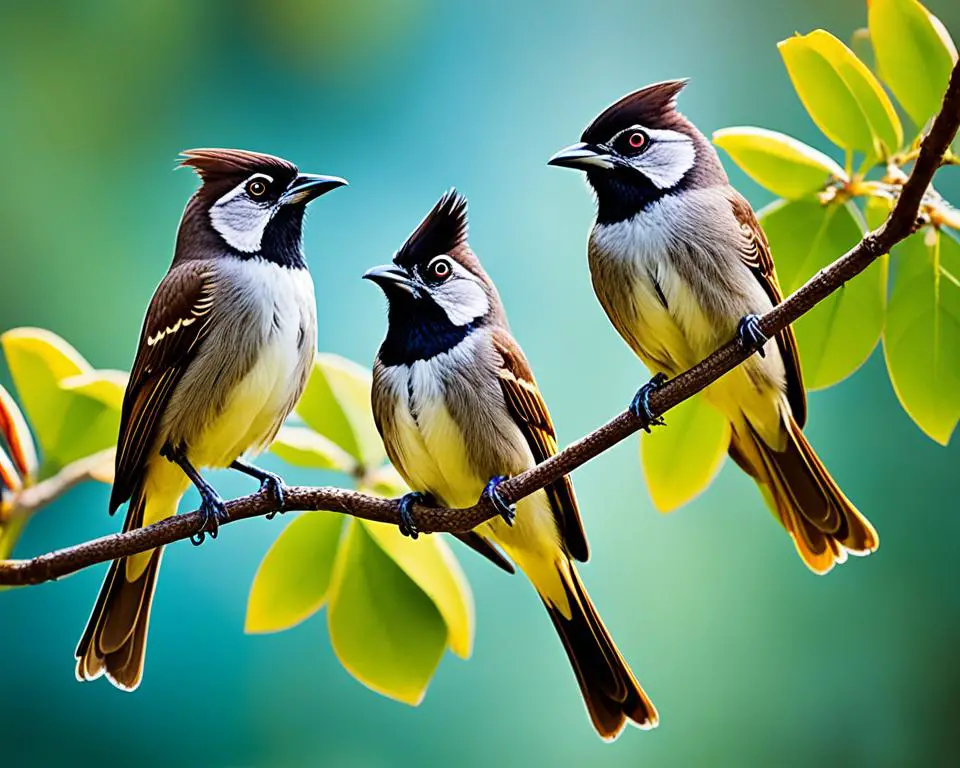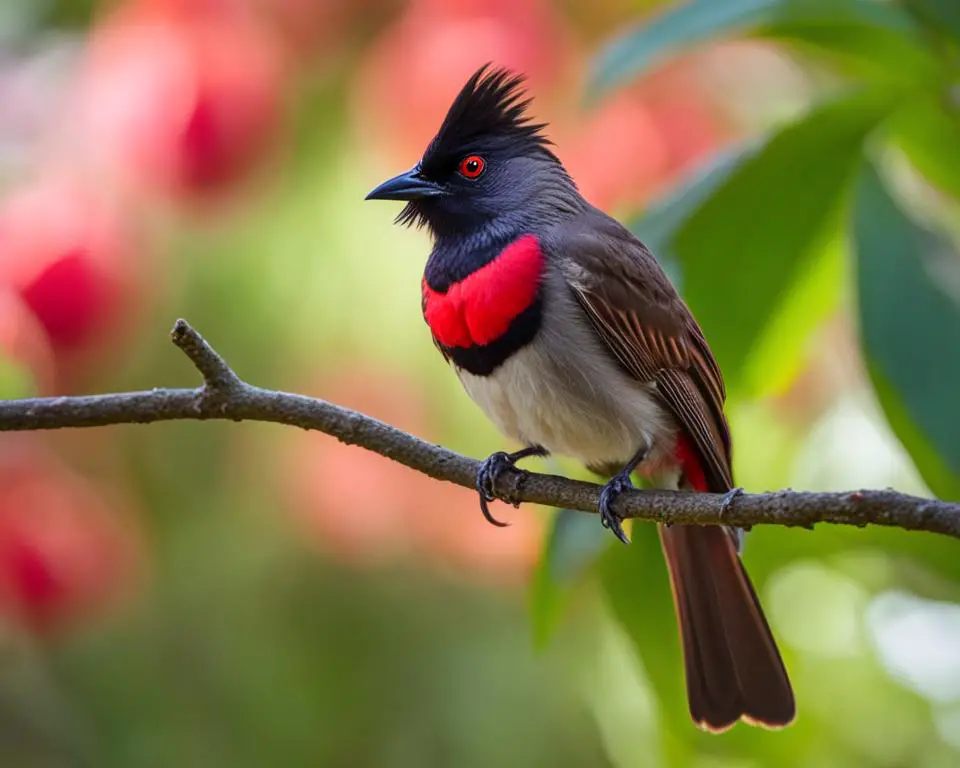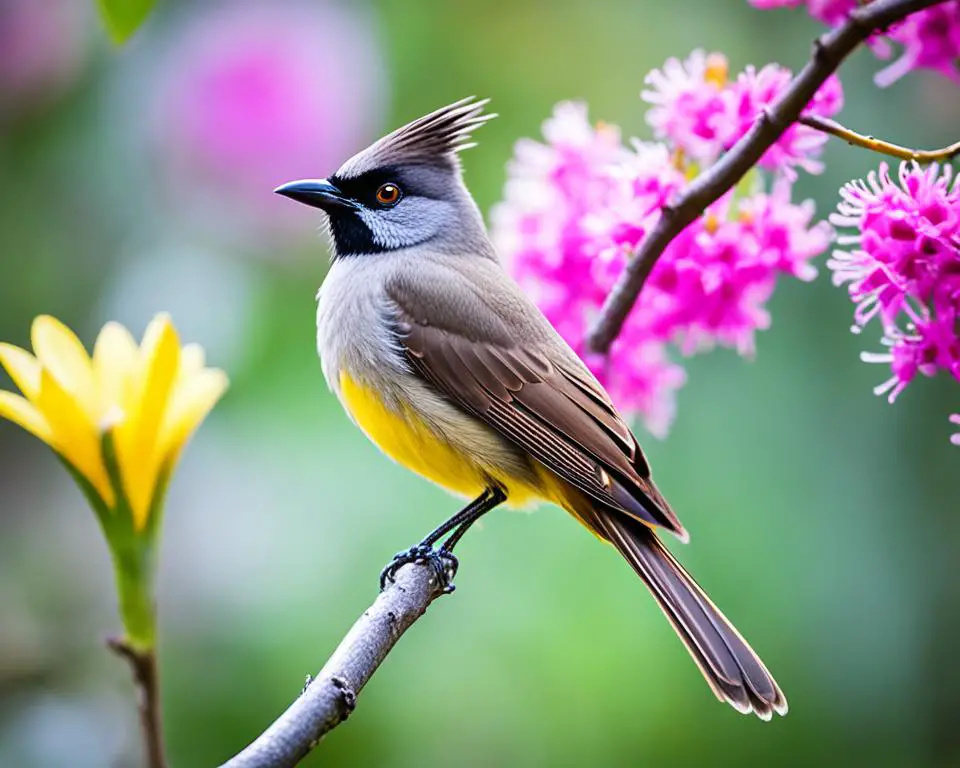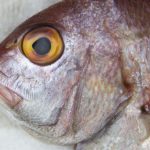As a lover of the natural world, you’re likely familiar with the melodic symphonies of songbirds gently coaxing the dawn. Among the feathered choristers, the bulbul bird species stand out with their distinctive calls that resonate across landscapes from Africa’s sprawling savannahs to the verdant forests of Indonesia. Referred to as passerine birds due to their perching habits, these creatures captivate birdwatching aficionados with their lively social interactions and pure vocal expressions.
Embarking on a birdwatching adventure? Your ears are in for a treat with the vocal prowess of these charming birds. While some ornithologists may describe certain bulbul calls as less than melodious, for you, it may transform into a surprisingly soothing soundscape, perfect for an immersive outdoor experience. Let’s tune into the bulbul’s world and unpack the array of harmonies they bring to Earth’s natural orchestra.
Discovering the Bulbul: A Widespread Songbird
Imagine a world echoing with the intricate melodies of the passerine bird, a creature whose presence graces a vast array of environments around the globe. The songbird you’re picturing is none other than the bulbul, a widespread songbird known for its vibrant chirping and adaptability. As you embark on your birdwatching ventures, you may find the bulbul distribution to be as varied as the landscapes they inhabit, from the lush tropics of Asia to the diverse ecosystems of Africa and the Middle East.
In your quest to explore these songbirds further, you’ll learn that bulbuls possess a remarkable global presence, flourishing in both rural and urban settings. This adaptability not only illustrates their survival prowess but also offers you, the avid bird observer, multiple opportunities to witness their beauty across continents. Indonesia, with its myriad islands and tropical climes, makes for an exemplary example of bulbul inhabitants thriving in a lush paradise.
- The rich, green canopies of Africa’s forests resonate with their tunes.
- Middle Eastern gardens are often visited by these musical guests.
- The sprawling cityscapes and remote areas of tropical Asia provide a concert of bulbul songs.
As we delve into the world of these charming songbirds, their ubiquity and vivacious personalities continue to enchant those fortunate enough to cross their paths. With your binoculars at the ready and the knowledge of bulbuls’ widespread distribution, you’re all set to enjoy the natural symphony they conduct no matter where your travels might take you.
Unveiling the Bulbul’s Identity: Physical Characteristics
As you explore the diverse world of bulbul species, you’ll discover a breathtaking array of unique physical traits that set these songbirds apart. Their picturesque array of forms and features is a testament to the adaptability and evolutionary creativity at play within the bulbul family, comprising over 166 recognized species.
Let’s venture into the attributes that make bulbul identification a fascinating aspect of birdwatching. Paying close attention to the physical characteristics of bulbuls, you might note the nuances in tail length and wing shape—two distinct markers that are vital for distinguishing between the myriad forms these birds take.
The Impressive Range of Bulbul Species
Within the wide realm of bulbuls, you’ll find species varying from the tinier, more delicate flyers to the fuller, sturdier variants. Each of these creatures is shaped by its unique habitat, dietary habits, and lifestyle. Whether it’s the smaller, nimble African bulbul navigating the dense rainforests or the larger, robust Asian counterpart residing in open woodlands—each species tells its own evolutionary tale.
Distinctive Features: Tail Length and Wing Shape
A bird’s tail and wings are like fingerprints—no two species wear them quite the same. In bulbuls, tail length can serve as a macro-indicator of their environmental adaptations, with longer tails useful for agile maneuvers through tight vegetation and shorter tails favoring open spaces. Meanwhile, the wing shape offers insights into flight patterns and behaviors, with rounded wings suggesting a propensity for quick bursts of speed, essential for navigating forested habitats.
If ever you find yourself out in the field, note these details. Observing the light dance across the sleek, varicolored plumage of a bulbul, admiring the distinct white rump of one, or the vibrant red vent of a red-vented bulbul, serves not only to delight but also to educate. Your birdwatching endeavors not only bring you into the company of these winged wonders but also further the understanding of their roles in our world’s ecosystems.
Exploring Bulbul Habitats: From Africa to Asia
With an impressive versatility, bulbuls have mastered life in contrasting landscapes. As you journey from the deep greens of the African tropics to the vast expanses of the Asian continent, the adaptability of the bulbuls becomes stunningly apparent. The niches they occupy highlight a fascinating ecological adaptability, allowing them to thrive across diverse regions.
These melodious birds have embraced various biomes, with bulbul habitats ranging from the dappled sunlight of tropical forests to the more exposed and arid open areas. As you immerse yourself further into the study of their habitats, you’ll find that the African bulbuls are often associated with lush, verdant rainforests, while many Asian bulbuls are adapted to living in more open spaces, such as scrublands and agricultural fields.
Bulbul Presence Across Continents
The sight and sound of bulbuls may greet you on multiple continents, each offering its own set of challenges and opportunities for these resilient birds. The widespread distribution of bulbuls speaks to their remarkable ecological success.
Preferred Environments: Understanding Bulbul Habitats
While it’s true that bulbuls exhibit variety in their living preferences, they generally share an affinity for regions that offer safety and sustenance. The diverse range of habitats occupied by bulbuls tells a story of their evolutionary journey, a tale of adapting wingbeats and cultural songs that echo through ecosystems.
The Vocal Virtuosos: Bulbul Calls and Songs
As you immerse yourself in the world of birdwatching, you’ll soon discover that bulbul vocalizations are as varied and complex as their vibrant plumes. These vocal virtuosos are renowned for their repertoires that richly contribute to the ambient concert of bird communication.

Every chirp and song is a chorus of ecology, each note crafted to carry across the canopy or through the brush. The diverse array of soundscapes created by bulbuls reinforces their status as master communicators of the avian world.
Understanding the Unmistakable Bulbul Chirp
The unique call of the bulbul, often described as a melodic chirp, acts as both a beacon and a boundary. These melodious sounds serve purposes that range from claiming territory to forging social bonds within flocks. Whether their calls pattern the morning air or punctuate the evening’s silence, they are unmistakable signatures of these feathered virtuosos.
Vocal Variations Among Different Bulbul Species
If variety is the spice of life, then the bulbul species are the spice merchants of the avian marketplace. Just as a spice market teems with variety, so too does the bulbul family display a fascinating spectrum of calls and songs. From the nasal notes of the brown-eared bulbul to the sharp “pick-pick” calls of the red-vented bulbul, each vocalization is tailored to the needs and environments of the species.
Consider the red-vented bulbul, with its call resembling the phrase “ginger beer,” a sonic delight for bird enthusiasts. These sounds not only differentiate species but also contribute to vital ecological communication, capable of alerting other birds to potential dangers or asserting their presence in a territory.
| Species | Distinct Vocalizations | Purpose of Calls |
|---|---|---|
| Brown-eared Bulbul | Nasal and continuous | Territory marking and mate attraction |
| Red-vented Bulbul | “Ginger beer” or “pick-pick” | Socializing and alarming |
| Red-whiskered Bulbul | Melodic and flute-like | Mate attraction and social bonding |
What’s more, these vocal virtuosos often engage in duets, highlighting their advanced social structures and complex forms of bird communication. This symphony of sounds offers a window into understanding the evolutionary paths these birds have taken, making every bulbul encounter a learning experience about the nuances of nature’s own music.
The Monogamous and the Polygamous: Bulbul Mating Habits
In the avian tapestry of nature, the bulbul mating habits bear a rich pattern of fidelity and variety. While many species of monogamous birds champion strong pair bonds, bulbuls often defy simple classification, with their breeding behavior presenting a captivating look into the complexities of avian relationships.
Witness the typical scenario: a male bulbul’s devotion materializes as he dutifully provides for the female during incubation, embodying the cherished family portrait of monogamy. Yet within the bulbul’s world, the conventional is occasionally eclipsed by instances of polygamous bulbuls, adding a rich narrative to the reproductive strategies that percolate through these feathered communities.
Bulbuls’ mating roles
- Male and female partnership in nurturing and feeding
- Exhibit of courtship rituals and territorial songs
- Role shifts in polygamous species impacting family dynamics
The diverse dynamics among bulbuls offer a nuanced understanding of their social structures. Monogamous birds like bulbuls create enduring pair bonds and allocate significant resources towards raising offspring. Contrarily, polygamous bulbuls juggle multiple relationships and as a result, may experience variances in familial stability and breeding success.
| Species | Mating System | Parental Roles | Impact on Offspring |
|---|---|---|---|
| Typical Monogamous Bulbul | One-to-one pairing | Shared incubation and feeding | High parental care, stable development |
| Polygamous Bulbul Variants | Multiple pairings | Varied parental involvement | Potentially wider genetic diversity but less stability |
As you explore the fascinating intricacies of bulbul breeding behavior, remember that each song you hear may be more than a mere call—it might resonate with stories of romance, rivalry, and the relentless drive to thrive across generations.
Fun Facts About Bulbuls: An Avian Revelation
Encountering the bulbul is to discover a wealth of intriguing bird behaviors that are as delightful as they are enlightening. These avian wonders of the natural world extend far beyond what meets the eye, offering a glimpse into complex social dynamics and communication methods that can truly be described as avian revelations.
Beyond the Common: Intriguing Bulbul Behaviors
As you observe the merry dance of bulbuls in their native habitats, you might be privy to some of the most intriguing bird behaviors. Far from being mere songsters, these birds engage in acts that reflect high levels of intelligence and sociability, pushing the boundaries of what we typically understand about avian life.
- Teamwork in nest building shows their cooperative spirit, often seen as a couple orchestrates the construction of their safe haven in unison.
- Curious and playful, bulbuls can be spotted engaging in what appears to be recreational activities, frolicking among branches with their kin.
- Resourcefulness abounds as they adapt their diets based on seasonal availability, with some even developing a taste for small insects or geckos.
These examples stand testament to the fascinating world of bulbuls, revealing behaviors that continuously pique the interest of bird enthusiasts and researchers alike.
https://www.youtube.com/watch?v=GaPqhDGv37Y
The Familial Bonds of Bulbuls: A Closer Look
Perhaps one of the most touching insights into the lives of these birds is the strength of bulbul family bonds. It’s not uncommon to spot juvenile bulbuls returning to their natal nests to offer nest assistance to their parents, a rare behavior in the bird kingdom that exemplifies the close-knit family structures within the species.
| Behavior | Description | Impact on Family Unit |
|---|---|---|
| Alloparenting | Young from previous clutches help to raise the new chicks | Enhances survival rates and family cohesion |
| Monogamous Pair Bonds | Long-term partnerships for breeding and co-parenting | Ensures a stable upbringing environment for offspring |
| Shared Incubation Duties | Parents take turns in warming the eggs | Distributes responsibility and conserves energy for both parents |
| Nest Defense | Both parents protect the nest from predators and intruders | Increases the likelihood of chick survivability |
These behaviors are more than mere instincts; they represent a sophisticated level of social organization that demands respect and admiration. Indeed, uncovering the familial interactions of bulbuls adds a layer of wonder to our understanding of these birds beyond their pleasant melodies.
As you venture into the world of bulbuls, embrace the opportunity to witness the nuanced complexity of their lives. From the collective nest building to the reverent care of kin, each behavior observed is a thread in the vibrant tapestry of bulbul family bonds—a true avian revelation for bird watchers and nature enthusiasts alike.
Bulbuls in Your Backyard: The Bird as a Pet
Among the enchanting chorus of nature’s soundtrack, bulbuls as pets have emerged as a harmonious addition to many households, captivated by their dynamic personalities and melodic tunes. This fondness has led to the red-whiskered bulbul and red-vented bulbul becoming charming inclusions in the pet trade, embraced for their beauty and delightful vocalizations. These particular species stand out not just in the wild but also in domestic spaces, filling homes with their natural songs.
The Pet Trade Phenomenon: Red-Whiskered and Red-Vented Variants
Why do these bulbuls enjoy such favor among bird lovers and pet enthusiasts? It is their alluring combination of pleasing aesthetics and vocal attributes that have led the red-whiskered bulbul and red-vented bulbul to become prized possessions. In contrast to the notoriously less captivating calls of some other bulbul species, these birds offer a more symphonic presence that can be a genuine joy to awaken to each morning.
As you consider welcoming a bulbul into your life, it’s worth noting the care and commitment they require. Ensuring a space that mirrors their natural habitat to some extent will contribute to their wellbeing and longevity as companions. Let’s take a closer look at the popularity of these avian friends in home settings:
| Bulbul Species as Pets | Desirable Traits | Considerations for Care |
|---|---|---|
| Red-Whiskered Bulbul | Vibrant plumage, interactive personality | Requires enrichment and social interaction |
| Red-Vented Bulbul | Distinctive melodies, sociable nature | Needs ample space for flying and exercise |
When choosing bulbuls as feathered companions, it’s beneficial for you to understand not just their aesthetics but also their nature and song. Whether it’s the warm, melodious quality of the red-vented bulbul or the striking look and playful character of the red-whiskered bulbul, these birds can certainly enrich your surroundings, offering a slice of the wild and a daily soundtrack that brightens any home.
The Red-Vented Bulbul: An Invasive Species?
When it comes to bird introductions, your awareness of ecological impact is crucial, particularly concerning species like the red-vented bulbul. An adaptable and prolific bird, it finds its way to the list of the world’s most formidable invasive species. Having spread its wings beyond its native lands, the red-vented bulbul has made homes where it wasn’t intended to be, causing notable ecological waves in regions like the Pacific islands.
The ability of these birds to flourish in new territories is impressive, yet this very trait leads to their reputation as invaders after a bird introduction to non-native areas. The red-vented bulbul is a sturdy example of adaptability, but its presence in foreign ecosystems is not without consequences.

Why should you be concerned? The infiltration of the red-vented bulbul into non-native habitats can lead to significant shifts in local bird populations. It competes with indigenous species for resources, often winning the battle, and its hearty appetite can affect agricultural practices by feeding on fruit crops. This intrusion, over time, reshapes the balance of local ecosystems, which can ripple out to affect biodiversity and the natural order.
Let’s look at a comparison of the red-vented bulbul’s influence:
| Area of Impact | Ecological Effects |
|---|---|
| Agriculture | Damage to fruit crops, leading to financial loss and altered farming techniques. |
| Native Bird Populations | Competition for resources resulting in the displacement or decline of local species. |
| Seed Dispersal | Spread of invasive plant species, changing native plant communities. |
| Habitat Dynamics | Altered habitat structures due to change in food chain dynamics. |
The ecological impact of the red-vented bulbul serves as a case study on the effects of moving species from their endemic locations to new environments. As you reflect on the significance of each creature within its ecosystem, it becomes increasingly clear that introductions of non-native species can result in profound ecological shifts, reaffirming the need for responsible wildlife management and conservation practices.
Identifying the Red-Vented Bulbul: Unique Markings
When identifying bulbuls, especially the red-vented bulbul, ornithologists and birding enthusiasts relish the task, thanks to its distinct features. Revered for its unique plumage and striking color contrast, the red-vented bulbul is not only a visual treat but also a remarkable species to observe in its natural habitat.
The red-vented bulbul is characterized by a vibrant and comprehensive range of markings. As a seasoned birdwatcher, your skill in recognizing this bird plays a vital role in understanding and appreciating the diversity within the avian world. Let’s explore the red-vented bulbul characteristics that make this species easily recognizable.
Known for the following quintessential features:
- **Short Crest:** Instantly noticeable, the crest gives this species a proud and distinctive profile.
- **Dark Brown Body:** A closer look reveals a unique, scaly pattern across the bulbuls’ warm-hued body.
- **Black Head:** Elegant and bold, the head presents a beautiful contrast to the bird’s brown body.
- **Vibrant Red Vent:** This is the bird’s namesake; the radiant, red vent, a splash of color that’s impossible to miss.
- **White-Tipped Black Tail:** This final touch of white on the black tail makes identification from afar an achievable task.
Beyond these distinct characteristics, the bird’s entire essence is a symbol of nature’s beauty. Whether you’re casually watching feathered friends in your backyard or conducting a field survey, noting these attributes will assist in the accurate identifying of bulbuls among other birds.
| Characteristic | Description | Significance |
|---|---|---|
| Short Crest | Catchy and square-shaped head | Enhances silhouette and profile recognition |
| Scaly Body Pattern | Dark brown with scalloped markings | Contributes to the bird’s camouflage in habitat |
| Red Vent | Bright reddish undertail coverts | Ease of identification during flight |
| White-Tipped Tail | Contrasting terminal band on the tail | Visual ID marker, especially noticeable in flight |
In summation, the red-vented bulbul is a testament to the intricacies of avian design, from its unique plumage to the melodic tunes it shares. This bird not only enriches the biodiversity of its environment but also complements the observers’ experience with its alluring aesthetics.
Nesting and Reproduction: The Bulbul Breeding Cycle
As you delve into the life cycle of these adaptable songbirds, the bulbul breeding cycle reveals remarkable resilience and versatility. Through observing nesting behaviors, you’ll gain insights into their successful continuation as a species. With each carefully constructed nest and clutch of eggs, bulbuls underscore their ecological importance and the sheer instinct to propagate.
Insights into Clutch Size and Egg Incubation
The journey from nest building to the emergence of chicks is a delicate process, heavily influenced by clutch size and egg incubation periods. The clutch, typically hosting two to three eggs, represents potential new life that requires meticulous care. The incubation period, averaging around 14 days, demands the attention of the expectant bulbul parents, as they take turns ensuring the warmth and protection of their future offspring. It’s during this time that pair bonds are fortified, highlighting their communal approach to nurturing the next generation.
Building a Home: Nest Construction and Location
When it comes to nest construction, bulbuls exhibit impressive adaptability, choosing locations that range from the natural crooks of trees to man-made structures. The architecture of a bulbul’s nest is a testimony to their resourcefulness, integrating materials from their surroundings to create a secure abode. These feathered engineers highlight their nesting behaviors as a symbiotic relationship with the environment, ensuring their young have a safe place to develop before taking their first flight.
| Nest Feature | Description | Significance |
|---|---|---|
| Location | Varies from tree branches to human edifices | Shows adaptability and resilience in finding safe nesting spots |
| Materials | Twigs, leaves, feathers, and even man-made debris | Utilizes available resources, indicating resourcefulness |
| Design | Typically cup-shaped, carefully lined for cushioning | Ensures comfort and security for the eggs and chicks |
| Construction | Both male and female may participate | Reflects strong pair bonds and shared parental investment |
In your own backyard, you may one day witness the result of the bulbul breeding cycle, observing as attentive parents dutifully feed their chirping young. Such a moment not only connects you to the natural world but also provides a fascinating peek into the perpetuation of the bulbul lineage, a process that captures the essence of life’s enduring cycle.
The Bulbul Diet: A Varied Palate
As you delve into the fascinating world of bulbuls, you’ll find that their dietary preferences embody versatility and opportunistic feeding—traits that enable them to thrive across various habitats. The bulbul diet reflects an adaptable foraging behavior that aligns perfectly with their survival in a mix of environments.
With a varied palate that encompasses a broad range of edibles, bulbuls are recognized as both fruit-eating birds and skilled insectivorous birds. This combination positions them as crucial players in their ecosystems, cycling nutrients and aiding in the maintenance of plant and insect populations.
Feeding on Fruits and Insects: A Bulbul’s Meal
The prevalence of fruit in the bulbul’s diet has earmarked them as key agents in seed dispersal, enhancing the biodiversity and health of their habitats. As they consume fruits, the bulbuls inadvertently take on the role of moving seeds through the landscape, where they may germinate and grow, contributing to the robustness of local flora.
Yet, their diet isn’t limited to just sweet treats. The inclusion of insects and other invertebrates adds a layer of complexity to their feeding habits. By preying on these creatures, bulbuls help keep insect populations in check, acting as natural pest controllers that benefit both the ecosystem and agricultural interests.
Occasionally, bulbuls may be seen consuming the petals of flowers, sipping nectar, or even nibbling on the leaves of certain plants like Medicago sativa. Such dietary diversity isn’t just fascinating; it reveals their remarkable adaptability, with bulbul foraging behavior often shifting with seasonal food availability and environmental changes.
| Food Source | Bulbul Feeding Habits | Ecosystem Impact |
|---|---|---|
| Fruits | Primary diet component, consumed across species | Seed dispersal, enhancing plant diversity |
| Insects | Supplemental diet, particularly for insectivorous species | Natural pest control, population balancing |
| Nectar and Petals | Alternate food sources, contributing to pollination | Supporting pollination processes, aiding flower reproduction |
Whether observing bulbuls in the wild or in the tranquility of your own backyard, it’s clear that these birds are not just mere songsters but also prominent foraging specialists, reflecting the complexity and interconnectedness of the natural world. Next time you witness a bulbul in search of its next meal, consider the intricate roles they play—a small bird with a significant ecological footprint.
Bulbul Impact on Ecosystems: Seed Dispersal and Pest Control
Imagine strolling through your garden and witnessing bulbuls navigating from branch to branch. As they indulge in the fruits your garden offers, their bulbul foraging behavior isn’t just a sight to behold; it plays a pivotal role in the ecosystem impact of your local environment. These birds contribute not only to the natural beauty of your surroundings but also engage actively in seed dispersal and natural pest control.
Now let’s delve deeper into how bulbul feeding habits aid in cultivating the landscape’s diversity. When bulbuls forage on fruit-bearing plants, they inadvertently become integral players in seed dispersal. As the seeds pass through their digestive systems, they are deposited across varying locations, sometimes miles away from their origin, nestled in natural fertilizer. This process fosters the growth of new plant life, anchoring the distribution of vegetation across the ecosystem.
This is not the end of their environmental contributions, however. The diversity of the bulbul diet means they also serve as agents of natural pest control. Their appetite for insects curtails potential overpopulation, maintaining a harmonious ecological balance. By indulging in a meal of pests, bulbuls help protect your garden from potential infestations, which could harm the very plants they seed through their other feeding habits.
Take a moment to observe and appreciate these avian inhabitants next time you’re outdoors. Their daily quest for sustenance culminates in profound and lasting benefits for our shared ecosystems. By simply going about its day, a single bulbul can contribute significantly to seed dispersal, a cornerstone of plant proliferation and biodiversity, as well as dovetailing into natural pest control.
| Aspect of Ecosystem Impact | Contributions by Bulbul Foraging Behavior |
|---|---|
| Seed Dispersal | Eating fruits and spreading seeds aids in the proliferation and genetic diversity of plant species. |
| Natural Pest Control | Consuming insects and other small pests aids in regulating their populations and protecting plant health. |
Your awareness of these intricate interconnections heightens not only your appreciation of nature’s vast web but also underscores the importance of each creature within their habitat. Bulbuls, with their cheerful demeanor and crucial ecological role, truly represent the serendipitous poetry of nature’s delicate balance.
The Science of Song: Analyzing Bulbul Vocalizations
Embark on an acoustic expedition where the science of bird song intersects with the fascinating world of bulbuls. These feathered virtuosos are at the heart of vocalization analysis, their songs offering a rich avenue for experts studying avian communication. A bulbul song is not just a call or melody; it is a profound exhibition of nature’s linguistic complexity. As you take a closer look, you’ll find ornithologists ardently deciphering the patterns and purposes behind these vocal displays.
Through meticulous analysis, researchers unveil the broad spectrum of communications encapsulated in each trill and chirp. In the arena of bird song science, bulbuls serve as a vibrant case study. Their diverse calls are not only for the pleasure of our ears but are essential for a host of critical life functions, including mating rituals and territorial declarations. As you step into this soundscape, you discover that every note carries weight, each modulation has meaning, whether it’s in the dance of courtship or the drama of an alarm signal piercing the stillness.
Delving into the intricacies of avian acoustics, bulbuls provide a captivating insight into the evolutionary sophistication of bird song science. Each vocalization analysis brings us closer to understanding these creatures’ social dynamics and survival strategies. So when you next hear the layered songs of a bulbul, remember you’re listening to an ancient language that’s been refined through countless generations, a true marvel of natural communication.










